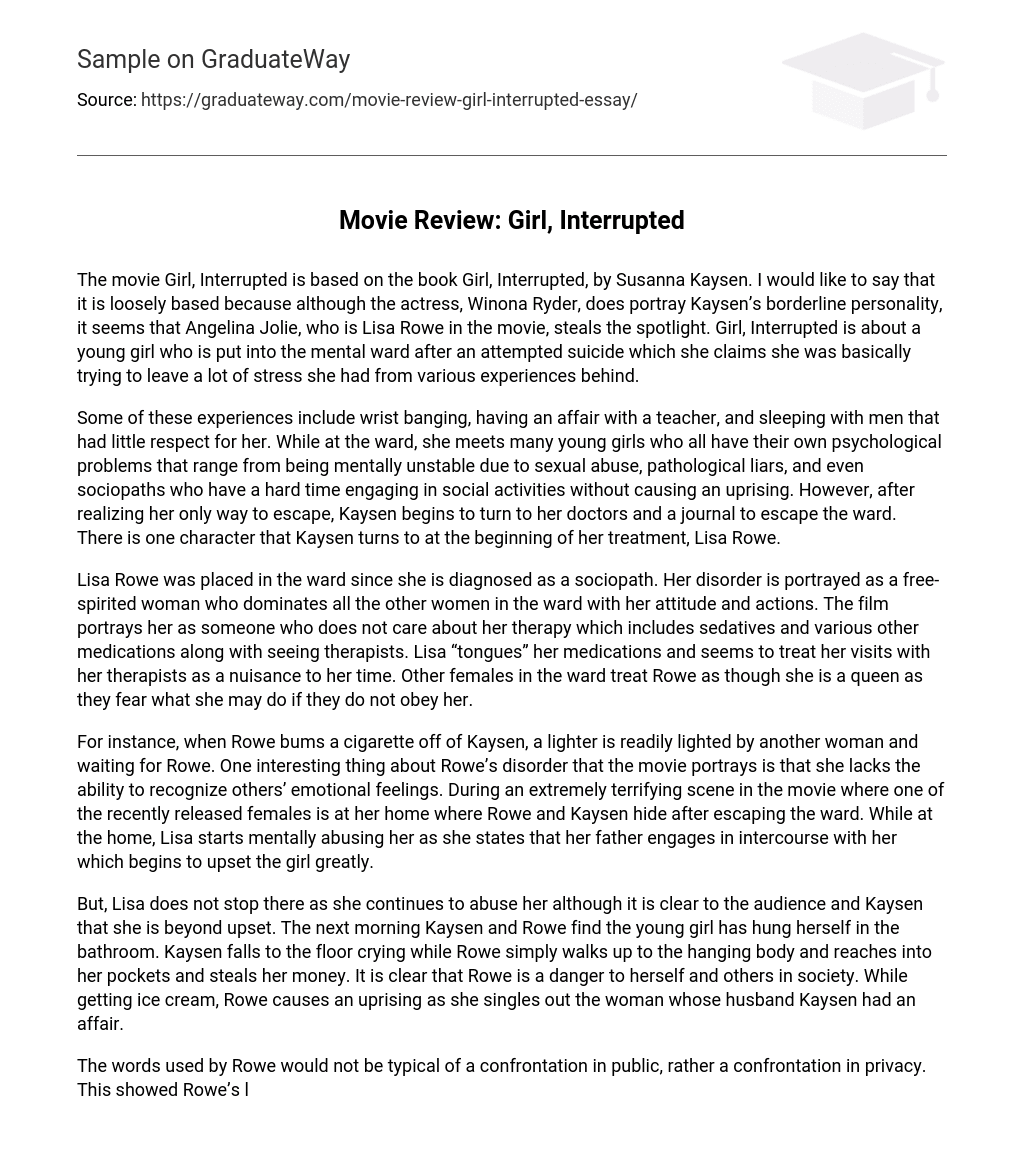The movie Girl, Interrupted is based on the book of the same name by Susanna Kaysen. Winona Ryder effectively portrays Kaysen’s borderline personality, while Angelina Jolie’s performance as Lisa Rowe truly mesmerizes viewers. The film depicts the story of a teenage girl who is admitted to a mental hospital after attempting suicide, which she attributes to the intense stress caused by various life circumstances.
In this passage, various experiences are described, including engaging in destructive behavior, entering a romantic relationship with an instructor, and being involved with disrespectful men. While staying at the psychiatric hospital, Kaysen meets several young girls who each have their own psychological issues. These problems range from instability due to sexual abuse to compulsive lying and even sociopathic tendencies that make it difficult for them to interact socially without causing disruption. Despite this, Kaysen realizes that her only means of escape is through relying on her doctors and using a journal as sources of comfort outside of the ward. At the beginning of her treatment, Kaysen forms a particular connection with one person: Lisa Rowe.
Lisa Rowe, diagnosed as a sociopath, is placed in the ward where she asserts dominance over the other women with her attitude and behavior. The film depicts her as someone who disregards her therapy, including taking sedatives and other medications and attending therapy sessions. Lisa nonchalantly consumes her medications, showing her indifference towards the treatment. Meanwhile, the other females in the ward view her as a queen and obey her out of fear of potential consequences.
For example, when Rowe asks Kaysen for a cigarette, another woman quickly lights a lighter for Rowe. One noteworthy aspect of Rowe’s condition depicted in the film is her inability to perceive others’ emotions. In a particularly frightening scene, one of the recently discharged women finds them at the home where Rowe and Kaysen have taken refuge after escaping the psychiatric ward. While they are there, Lisa verbally torments her by revealing that her father has sexual relations with her, greatly distressing the girl.
However, Lisa’s abuse towards Kaysen does not end there. It becomes evident to both Kaysen and the audience that Lisa is extremely upset. The following day, Kaysen and Rowe discover that the young girl has taken her own life in the bathroom. Kaysen collapses to the ground in tears, while Rowe nonchalantly approaches the hanging body and proceeds to steal her money. This incident makes it clear that Rowe poses a threat to herself and others in society. Later, while getting ice cream, Rowe causes a disturbance by singling out the woman whose husband Kaysen had an affair with.
Rowe’s choice of words would not be appropriate for a confrontation in public. Instead, her words indicate a confrontation that would take place in private. This lack of consideration for those around her demonstrates Rowe’s disregard for others. Additionally, in the ward, she poses a threat to others by drugging a night guard and even threatening to drug Kaysen after reading her journal aloud to the other women in the ward. This clearly proves that if Rowe is left alone in a public setting, she has the potential to harm those around her. In my opinion, the film effectively portrays Rowe’s character.
The film’s impact is so powerful that it diverts attention from the main character, ultimately reducing societal stigma towards mental disorders. It demonstrates that despite their psychological challenges, these women are relatable – they have relationships and yearn for connection. The film’s influence on me was intense, sparking my interest in psychology and motivating me to comprehend the motivations behind their behavior. While watching the movie, I couldn’t help but contemplate why she displays apathy towards her loved ones.
One reason for choosing this film is the impressive portrayal of actors and actresses depicting psychological disorders. Despite not having these disorders themselves, their excellent portrayal indicates extensive research into each disorder to captivate the audience. Moreover, another reason for selecting this movie is the inclusion of multiple disorders, offering viewers a comprehensive glimpse into various psychological disorders in a single film.





